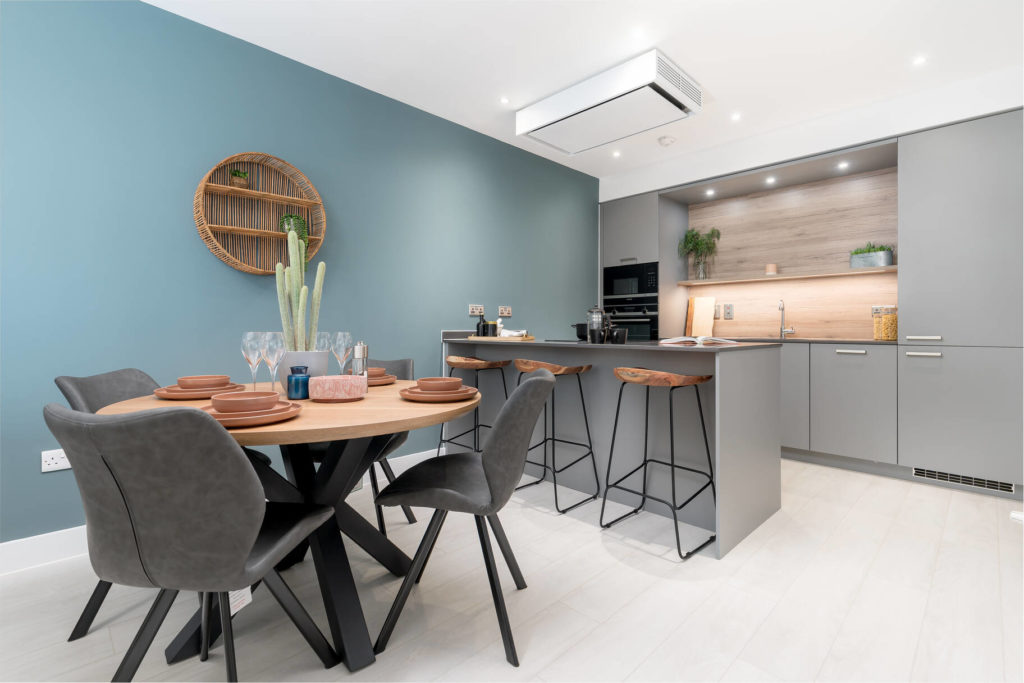Changing or replacing flooring becomes challenging after you’ve moved into a property, so it’s crucial to make the right choices in a new home. In this latest article in our Insight series of in-depth analyses of all-things property, Queensberry Properties’ sales and marketing director, Hazel Davies, guides homebuyers through the various options.
“There are many aspects of personalising a new-build property which take time. It’s advisable to wait a year before adding wallpaper to drying plasterboard, while gardens often benefit from landscaping at specific times of year – trees flourish when planted in autumn, not spring. Some decorations (mirrors and freestanding storage in particular) work best once their intended destinations have been measured for size, to ensure they fit snugly.
“Flooring though, is an exception to this rule. Once furniture is in situ and daily life resumes, clearing rooms in preparation for new flooring represents a major challenge. It’s far more practical to have flooring installed before the removal van disgorges your life’s belongings, even if you have to delay moving in after picking up the keys. But how can you make wise flooring choices for rooms as yet unlived in, especially if your only point of reference is a floorplan?
One room at a time
“Different rooms require different approaches to flooring; there’s no option that’ll work throughout a property. Think of those awful 1970s bathrooms with carpet around the toilet, or 90s kitchens with peeling beech laminate beside the sink.
“You can generally divide rooms into three main categories:
- Living spaces. Includes lounges, studies and dining rooms. Demanding a blend of practicality and comfort, options include carpet, solid wood and engineered vinyl.
- Working spaces. Includes kitchens, utilities and bathrooms. Flooring needs to be waterproof and easy to clean, with tiles and vinyl among the leading choices.
- Sleeping areas. Includes bedrooms and nurseries. The comfort and warmth of carpet makes it a default choice unless allergies steer you towards laminate or solid wood.
Plan for daily life
“It’s important to consider a particular space’s characteristics, and how it’ll be used. A lounge with doors opening onto a balcony or garden requires flooring capable of shrugging off mud and wet footprints; engineered vinyl would be more practical here than carpet. If you’re prone to clumsiness (or have a young child), porcelain tiles are more slippery than rough-surfaced ceramic alternatives. Using a bedroom as a music room might steer you towards thick rugs, which will prevent sound leaking into surrounding apartments.
Sound underpinnings
“Soundproofing membranes underneath flooring are only necessary for musicians or the owners of high-power subwoofers. What you will need beneath your feet is underlay. A premium cushioned underlay transforms the softness of carpet, and ensures laminate lasts longer. Speaking of hard flooring, it usually requires beading around the edges if it’s not being laid underneath skirting boards. Removing skirting boards is time-consuming and fiddly, but it delivers a far neater visual effect and makes vacuuming and mopping easier.
Stick to neutral colours
“A brightly coloured carpet might stand out amid a sample booklet of plain shades, and pastel laminate flooring has undeniable drama. However, choices made in a showroom or online don’t always work in situ. Colours clash in unexpected ways, and may preclude the introduction of coloured furniture, accessories or bedding. Stick to natural and neutral flooring shades – ideally variations on brown or grey. This won’t restrict what furnishings you choose, and you can redecorate as boldly as you wish once the walls dry out.
Weigh up the costs
“The adage ‘you get what you pay for’ is especially pertinent with flooring. Choosing a carpet that’s half the price of a quality alternative is a false economy if it only lasts half as long, especially if it feels less luxurious. Flooring leads a hard life, and we’d always recommend investing in higher-quality options if your budget allows. Don’t go overboard though – there’s no need to install industrial-quality laminate in a guest bedroom, or pick pricy herringbone parquet if you prefer the visual impact of solid oak planks”.

